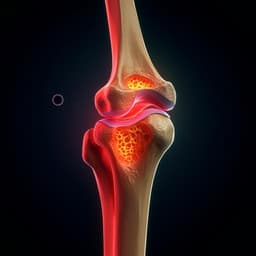
Environmental Studies and Forestry
Storm surge and ponding explain mangrove dieback in southwest Florida following Hurricane Irma
D. Lagomasino, T. Fatoyinbo, et al.
Discover how mangroves in southwest Florida reacted to Hurricane Irma! This study, conducted by David Lagomasino and colleagues, reveals that while many mangroves resprouted quickly, some faced unprecedented dieback due to storm surge and hydrologic conditions. The findings stress the importance of tidal restoration and hydrologic management to build resilience against future storms.
Playback language: English
Introduction
Worldwide, mangrove forests provide crucial protection to inland areas from coastal storms, preventing billions of dollars in property damage and significant flooding annually. The benefits are particularly pronounced during cyclones. The economic advantages are also substantial, as coastlines with extensive mangrove cover experience shorter periods of economic inactivity following hurricanes. However, projected increases in the frequency and intensity of tropical cyclones pose a significant threat. More frequent damage to mangrove forests could create a positive feedback loop, reducing their protective capacity and increasing vulnerability to future storms.
Damage to mangrove forests from tropical cyclones varies widely, ranging from temporary leaf loss to complete tree mortality. Recovery also varies based on factors like storm intensity and soil conditions. In some cases, storms deposit nutrient-rich sediments that boost mangrove growth. Conversely, in other areas, initial damage is exacerbated by delayed mortality, hindering recovery for extended periods. Therefore, identifying the specific locations and mechanisms behind widespread mangrove collapse is crucial for understanding the vulnerability of coastal ecosystems and developing effective mitigation strategies.
South Florida boasts the largest continuous mangrove forest in the United States, a significant portion of which is located within Everglades National Park. However, human development has constrained the landward migration of mangroves and altered coastal hydrology, increasing vulnerability to sea-level rise, saltwater intrusion, and ponding. These chronic stressors, combined with the intense winds, storm surge, and prolonged flooding associated with hurricanes, push mangroves to their limits. The risk of mangrove dieback is spatially variable, depending on the interplay between hurricane characteristics, forest structure, species composition, geomorphology, elevation, and prior hydrologic connectivity.
Hurricane Irma, which made landfall in South Florida in September 2017, provided a devastating case study. Its high winds and substantial storm surge (up to 3 meters) significantly impacted the southwest coast. The storm's powerful winds caused widespread damage, while the surge reshaped coastal topography. Previous studies using satellite imagery at smaller scales have tracked hurricane impacts on mangroves, but few have investigated the three-dimensional changes in forest structure necessary to understand the diverse impacts and resilience limits at larger scales. This study combines airborne and satellite remote sensing data to comprehensively assess the damage and subsequent recovery of mangroves in the year following Hurricane Irma.
Literature Review
Existing research highlights the critical role of mangrove forests in coastal protection and economic resilience. Studies have quantified the economic benefits of mangroves in reducing property damage and shortening periods of economic inactivity after hurricanes (Hochard et al., 2019; Menéndez et al., 2020; del Valle et al., 2020). Projected increases in tropical cyclone frequency and intensity (Bhatia et al., 2018; Sobel et al., 2016) emphasize the need to understand mangrove vulnerability. Previous work has documented the variable nature of damage from tropical cyclones, ranging from temporary defoliation to widespread mortality, with recovery depending on storm strength and edaphic factors (Danielson et al., 2017; Cahoon et al., 2003). Some studies show hurricanes depositing phosphorus-rich sediments that stimulate growth (Castañeda-Moya et al., 2020), while others reveal delayed mortality that limits recovery (Rivera-Monroy et al., 2019; Radabaugh et al., 2019). The impact of hurricanes on mangrove forests is complex, influenced by factors such as hurricane characteristics (Han et al., 2018), forest structure (Krauss & Osland, 2020), species composition, geomorphology, elevation (Smith et al., 2009), and previous hydrological connectivity (Lewis et al., 2016). Studies using satellite imagery have tracked mangrove damage and recovery (Zhang et al., 2019), but large-scale assessments of three-dimensional structural changes are limited (Zhang, 2008).
Methodology
This study integrated airborne and satellite remote sensing data to assess mangrove damage and recovery following Hurricane Irma. Airborne lidar data, collected before (April 2017) and after (December 2017) the hurricane using NASA Goddard's Lidar, Hyperspectral, and Thermal (G-LiHT) airborne imager, provided high-resolution (1-meter) three-dimensional information on vegetation structure across 130,000 hectares of coastal wetlands in South Florida. This data was combined with high-resolution satellite stereo imagery (DigitalGlobe's WorldView 2) and Landsat time series data to track ecosystem recovery across gradients of wind exposure, storm surge, species composition, and elevation.
The G-LiHT lidar data underwent standard processing to generate canopy height models, digital terrain models, and fractional vegetation cover (FVC) estimates. Digital surface models (DSMs) were derived from the WorldView 2 imagery using the Ames Stereo Pipeline (ASP). These DSMs were calibrated using overlapping G-LiHT lidar data to estimate mangrove canopy heights. Landsat 8 Operational Land Imager (OLI) imagery was used to map mangrove cover using a Random Forest classification trained on hand-selected points and validated against existing vegetation maps from the National Park Service. Time series of Landsat data were used to assess post-hurricane canopy cover changes by calculating the Normalized Difference Vegetation Index (NDVI) and the Normalized Difference Water Index (NDWI) for each image.
Pre- and post-storm FVC maps were generated using both lidar and Landsat data. A Random Forest classifier was trained on lidar-derived FVC data to classify Landsat imagery. Recovery times and resilience were estimated using the Landsat NDVI time series, comparing post-storm NDVI to pre-storm average values. The study analyzed the relationship between various parameters including elevation, storm surge, wind exposure, species composition, and mangrove forest structure (canopy height, FVC) to identify the factors driving mangrove dieback and resilience.
Key Findings
Hurricane Irma caused one of the largest recorded mangrove dieback events in the region, affecting 10,760 hectares in the first 15 months after the storm. This dieback was concentrated in low-lying areas (<10 cm above sea level) where storm surge exceeded 1.4 meters above ground level. Over 90% of the dieback occurred in areas where storm surge exceeded 1.4 m above the ground surface. The dieback was disproportionately concentrated in areas dominated by *Avicennia germinans*, a salt-tolerant species, with approximately 73% (7,750 ha) of the total dieback area impacted. Nearly 40% of *A. germinans* dominated forests died compared to less than 6% of other forest communities.
Structural damage, measured by changes in canopy height, varied based on wind exposure and pre-storm canopy height. Taller trees (>10 m) experienced the greatest height reductions (2.05-2.97 m on average), while shorter trees had smaller losses. A 15.3% reduction in mangrove canopy volume was estimated, strongly correlated with aboveground biomass. The largest losses were concentrated in major estuaries known for tall canopies and regular freshwater input and tidal flushing. Widespread mangrove defoliation, measured as FVC loss, was observed after the storm. Areas with greater than 40% FVC decline were more likely to experience dieback (61.5%), compared to areas with less severe FVC loss (38.5%).
Analysis showed that storm surge, topographic position, and drainage were the primary drivers of mangrove dieback. Delayed or failed recovery was largely confined to low-elevation, endorheic basins (areas with no outlet) and interior portions of larger mangrove patches. Impounded floodwaters, cut off from the tidal prism, likely contributed to increased porewater sulfides, a phytotoxin, and hypersalinization, leading to mangrove mortality. Natural and artificial barriers (roads, levees) exacerbated ponding and flooding. Pre-storm forest structure (canopy height, FVC), species composition, and storm characteristics also influenced damage patterns and recovery times. Taller trees suffered more wind damage, but this did not trigger dieback in well-drained areas. Tidal connectivity in some areas facilitated refoliation and seedling growth, accelerating recovery. The species *Rhizophora mangle* showed higher mortality rates than *A. germinans* or *Laguncularia racemosa*. The greater vulnerability of *A. germinans*-dominated stands to dieback may reflect competitive exclusion of other species in low-lying areas before the storm, or prolonged exposure to salt water after Irma, overwhelming even the salt tolerance of *A. germinans*. Prolonged inundation reduces primary productivity, suppresses nutrient uptake, and can create toxic conditions.
Discussion
The findings demonstrate that storm surge and subsequent ponding, rather than wind, were the primary drivers of the widespread mangrove dieback after Hurricane Irma. The concentration of dieback in low-lying, hydrologically isolated areas underscores the importance of considering topographic position and drainage patterns when assessing mangrove vulnerability. The interaction between storm characteristics (intensity and track) and landscape features (elevation, drainage) determined the extent and severity of the dieback. While wind damage affected canopy structure, it did not necessarily lead to mortality in well-drained areas with tidal connectivity. The resilience of mangroves in well-drained areas highlights the importance of maintaining hydrological connectivity for ecosystem health. The species-specific vulnerability of *A. germinans* highlights the need for consideration of species composition in vulnerability assessments. The results emphasize the need to move beyond simple wind speed metrics in assessing hurricane impacts on mangroves. Integrated assessments incorporating storm surge modeling, high-resolution topographic data, and species composition are essential for predicting and mitigating future mangrove losses.
Conclusion
This study provides critical insights into the factors influencing mangrove vulnerability and resilience to hurricanes. The findings highlight the importance of storm surge and ponding in causing mangrove dieback, emphasizing the need to consider hydrological factors in addition to wind speed in assessing hurricane impacts. The results underscore the importance of coastal management strategies focused on maintaining tidal connectivity and reducing hydrologic isolation in vulnerable areas. Future research should focus on developing predictive models that integrate storm surge, topography, species composition, and other relevant factors to more accurately assess and mitigate future mangrove losses. This includes enhancing coastal monitoring networks to improve surge warnings and guide mitigation efforts. Restoring freshwater inputs and tidal regimes in vulnerable areas will be key to improving resilience.
Limitations
While this study used extensive datasets to assess mangrove damage and recovery, some limitations exist. The analysis relied on remote sensing data, which may not fully capture all aspects of mangrove health and mortality. Ground truthing of remote sensing data would further validate the findings. The study focused on a single hurricane event, and further research is needed to determine the generalizability of these findings to other hurricane events and geographic locations. The study's focus on a specific region of southwest Florida limits its direct applicability to other mangrove ecosystems. Future research could investigate a broader range of mangrove ecosystems and hurricane events to improve our understanding of mangrove vulnerability.
Related Publications
Explore these studies to deepen your understanding of the subject.







